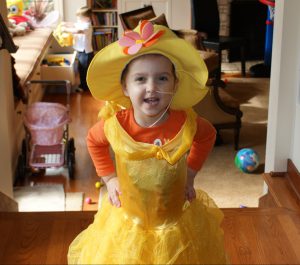
In August of 2009, when Katie Belle was just 3 1/2 years old, a persistent fever led her to Seattle Children’s Emergency Department where doctors discovered a baseball-sized tumor in her abdomen. She was diagnosed with high-risk neuroblastoma, a cancer that starts in immature nerve cells and develops into tumors. Her chance of survival: 35%.
“I felt like someone stuck a dagger in my stomach,” said Katie’s mother, Jennifer Belle. “I couldn’t breathe. However, I had to put on a brave face for Katie.”
For children with high-risk neuroblastoma, which according to the National Cancer Institute occurs in approximately one out of 100,000 children, Katie’s prognosis was not uncommon. On average, less than 50% of children with this disease live five or more years after diagnosis.
However, a Phase 3 trial performed by the Children’s Oncology Group (COG), and led by Seattle Children’s oncologist Dr. Julie Park, has found that adding a second autologous stem-cell transplant, which is a transplant that uses the patient’s own stem cells, to standard therapy improves outcomes for patients with high-risk neuroblastoma.
Today, Park presented the findings at the American Society of Clinical Oncology (ASCO) Annual Meeting, noting that at three years, about 61% of patients who received a double transplant were alive and cancer-free, compared to about 48% of those who received a single transplant.
For those patients who also received a form of drug-based immunotherapy after transplant that breaks down the protective tumor barriers and stimulates the immune system to attack cancer cells, about 73% of patients who received a tandem transplant were alive and cancer-free, compared to about 55% who received a single transplant. Park said the findings are promising given most neuroblastoma recurrences occur within two to three years from diagnosis, and patients who have not recurred at three years have a better chance of long-term survival.
“It’s incredibly exciting because these findings have changed the way we treat children with high-risk neuroblastoma in North America, and I believe will ultimately make a difference in patients’ survival,” said Park, who is also the chair of the COG Neuroblastoma Scientific Committee. “In 1990, 75% of kids did not survive. Through continued research, we keep moving the needle and improving survival, but we still have a long way to go in developing newer, less toxic therapies with fewer side effects.”
Katie’s journey to remission

When Katie was first diagnosed, her family immediately had the option to participate in the COG trial.
“While it was a lot to process, we chose to enroll Katie in the trial because her prognosis was poor and it’s critical to understand more about how to best treat this disease,” said Jennifer. “While we hoped it would work, we also knew that no matter the outcome, the researchers would at least learn something and it would be a way to help future patients.”
Katie’s treatment was aggressive, as it is for all children with her disease. Katie endured almost two years of treatment, which included multiple surgeries, six rounds of chemotherapy, the tandem stem-cell transplant, 14 days of radiation and five months of immunotherapy. In total, she spent more than 200 nights in the hospital.
Seven months after the end of treatment, Katie’s family finally got the news they’d been hoping for – she had no evidence of cancer. It was a tremendous milestone, but Jennifer knew they weren’t yet out of the woods.
“We felt great, but knew there was no guarantee that she’d stay cancer-free,” said Jennifer. “We continued to hold our breath for a long time after treatment was over, and then I remember feeling relieved at the two-year mark. Now we are more than five years out, and I am finally like, ‘Ok, we are done.’ We can finally live our life. It is freeing.”
In reflecting on the decision to participate in the trial, Jennifer is thankful for the opportunity.
“In looking at the results of the trial, there is a good chance Katie is here today because of the tandem transplant,” said Jennifer. “For that, we are grateful.”
Jennifer said Katie, now 10, is a precocious, fun-loving girl who loves to swim.
“She loves school, has a wonderful group of friends and is thriving,” said Jennifer. “The experience has also changed her outlook on life. After going through something so difficult, everything else seems relatively easy to her.”
Giving back to support research, help other kids like Katie

Due to all the aggressive treatments Katie had to undergo in order to save her life, she will have multiple long-term complications – a reality that has spurred her and her family to want to give back.
In 2010, they established the Katie Belle Neuroblastoma Research Fund to support Park’s research aimed at improving the effectiveness and reducing the toxic side effects of treatment for neuroblastoma. Each year, Katie also hosts a lemonade stand with her friends. To date, they have raised nearly $500,000.
“We are incredibly thankful that Katie is here today, and we want to do all we can to ensure that the kids who follow in her footsteps have even better prognoses and access to less toxic treatments,” said Jennifer. “We also feel very connected to Seattle Children’s and want to do anything we can do to give back.”
Katie adds, “Raising money for Dr. Park is important to me because I think kids who get cancer should have better cures and get medicine that works faster, because I spent a lot of time in hospital when I was little. And it would be great to have medicine that doesn’t make your hair fall out.”
Park is incredibly grateful for their support in her quest to continue to uncover new treatments for this disease.
“I am honored to have the support of Katie and her family,” said Park. “While we’ve made progress, we still have our work cut out for us in improving survival with less toxic therapies, but we are on the right path and will continue to raise the bar by looking at how we can leverage the biology of neuroblastoma and the immune system to improve treatment.”
The Children’s Oncology Group (COG), a member of the NCI National Clinical Trials Network (NCTN), is the world’s largest organization devoted exclusively to childhood and adolescent cancer research with over 9,000 experts worldwide working in over 200 COG member institutions. COG’s mission is to improve the cure rate and outcome for all children with cancer.
Resources:
- T-Cell Therapy for Recurrent/Refractory Neuroblastoma (Known as ENCIT-01)
- Seattle Children’s Cancer and Blood Disorders Center

